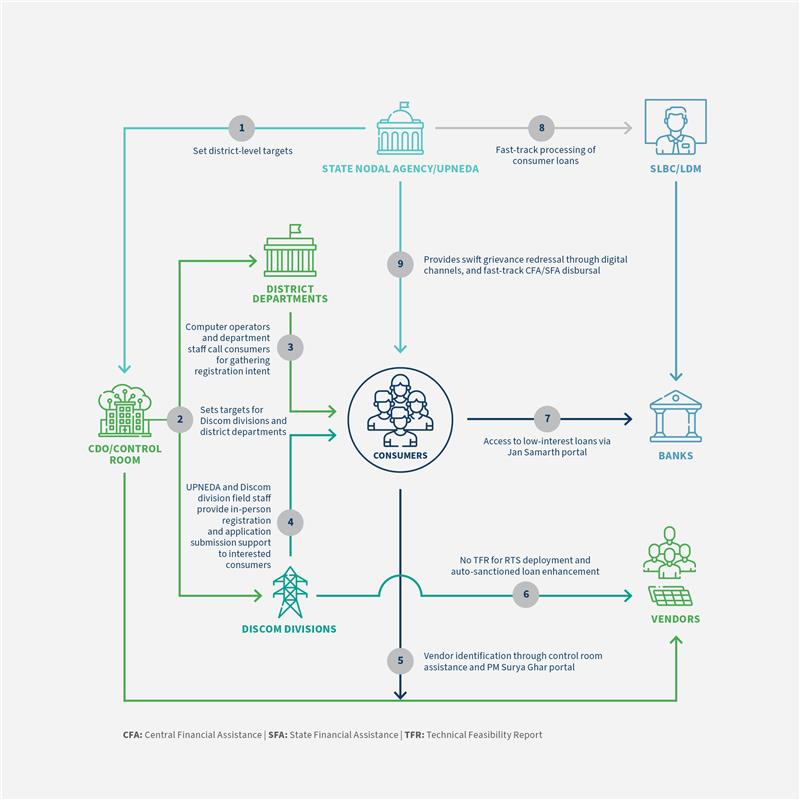
Brief | 2025
Can Rooftop Solar Power India’s Cities?
How India can bridge policy and practice, making rooftop solar a cornerstone of its clean energy transition
Additional contributors: Eleanor Adams, Laurie Stone, and Colm Quinn
India is seeing a resurgence in residential rooftop solar deployment. The national government’s flagship “Pradhan Mantri Surya Ghar (PMSG) Muft Bijli Yojana” is a nationwide program launched in February 2024 to solarize 1 crore (10 million) households by 2027.
The objective of the scheme is to provide low-cost electricity to consumers via rooftop solar (RTS). With about 1.4 crore (14 million) registrations so far and about 26 lakh (2.6 million) application submissions, the scheme has been gaining traction. In just one year, more than 800,000 houses have been solarized under the scheme — nearly surpassing the total solar growth achieved in the past decade.
However, with just over 5 percent of registered consumers having installed RTS so far, success requires accelerating the deployment process for those who have registered but haven’t yet installed a system. In order to reach the 10 million target, roughly 400,000 RTS systems must be deployed every month until 2027. A few champion states such as Uttar Pradesh, Gujarat, and Maharashtra may hold the key to successfully scale RTS adoption and can offer valuable insights for other Indian States. For example, Gujarat leads the country with 45 percent of registered consumers having installed RTS systems; in Maharashtra, the share is 20 percent.
Uttar Pradesh leads the way
A case in point is Uttar Pradesh, India’s most populous state, where the country has set a goal of solarizing 25 lakh (2.5 million) households in the wake of the announcement of the PMSG scheme — one-fourth of the PMSG target. It also offers an additional capital subsidy of ₹15,000 (US$175) per kW for the first 2 kW as part of its state solar policy, in addition to the capital subsidy offered under PMSG.
In Varanasi, a key district in Uttar Pradesh, more than 60,000 have registered (the highest across the state) and nearly 10,000 RTS systems have been installed as of December 2024, with a growth of roughly 15 times since the launch of the PMSG scheme. These installations form over 12 percent of the overall RTS installations in Uttar Pradesh. This is a remarkable achievement for a small district like Varanasi, given that it accounts for under 10 percent of Uttar Pradesh’s population.
RMI’s efforts in supporting the government of Uttar Pradesh have helped showcase a blueprint of the novel initiatives adopted in Varanasi that led to accelerated adoption of RTS by residential consumers. These initiatives were the result of concerted efforts by the district administration and effective mobilization of resources on the part of the UP New and Renewable Energy Development Agency, the state nodal agency (SNA) for renewable energy.
The district administration was key in undertaking the following measures:
- Setting up a control room for weekly monitoring of target achievement: Varanasi has set a target of solarizing 75,000 households under the PMSG scheme. Both officials from the SNA as well as the district administration carefully monitor the progress of division-wise targets through the effective mobilization of resources.
- Enhancing consumer outreach through in-person support and awareness campaigns: The SNA, along with Discom officials, provides in-person support to consumers through the process of registration and installation of RTS. Consumer awareness activities and mega camps for registrations were jointly organized by staff of the district departments and the SNA.
- Developing the ecosystem through engaging vendors and banking institutions: The vendor base in the state was doubled to increase active vendors in districts and enable consumer choice. At the same time, the state level banking committee was engaged to ensure easy access to finance for consumers.
- Streamlining digital processes and grievance redressal: The SNA helped streamline processes on platforms, including the Jan Samarth portal for availing low-interest loans, the PMSG portal for swift resolution of any subsidy disbursal challenges, as well as the Solar Samadhan portal for state-wide grievance redressal.
Innovations and best practices in RTS implementation from the Varanasi Model

Building on local successes is key
What we have uncovered in Varanasi is the need for persistent and planned action by the sub-national administration, which will be critical for target achievement under the PMSG scheme.
Scaling the lessons on stakeholder collaboration and ecosystem development from replicable models such as Varanasi and contextualizing them to specific cities and states can drive RTS adoption in the country. By building on these localized successes, India can effectively bridge policy and practice, making rooftop solar a cornerstone of its clean energy transition goals for 2030 and beyond.
